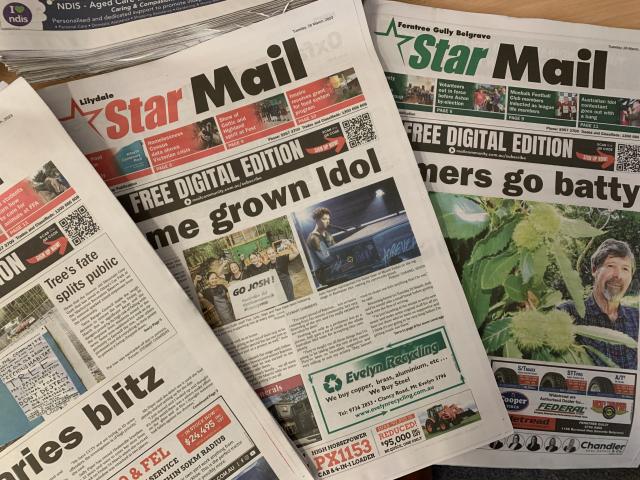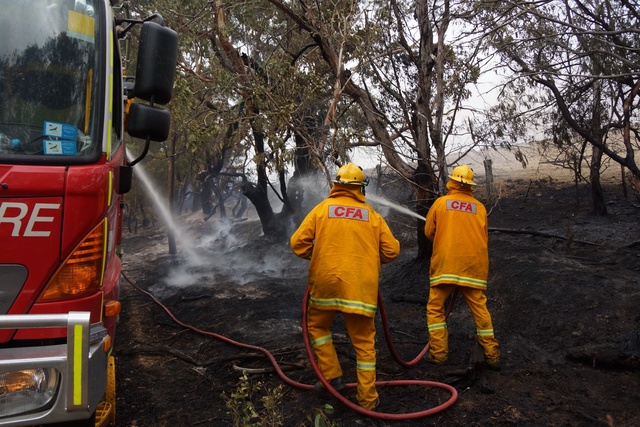Local print newspapers like Star Mail may survive the onslaught of online media.
A national report into local news sustainability is challenging the perception that print newspapers are dead.
The report is calling on governments to revise their advertising rules to help local news providers and better target regional and rural communities.
“Local and regional newspapers continue to play a significant role for local communities,“ Star News Group managing director Paul Thomas said.
“They provide a voice, an opportunity for informed public debate and hold the powerful to account.
“Star News Group is proud to continue to provide quality local news with balance and fairness but the conditions are tough.“
The report Media Innovation and the Civic Future of Australia’s Country Press made 22 recommendations.
The finding was the culmination of a three-year Australian Research Council project, led by Deakin University.
Deakin partnered with Country Press Australia, the nation’s peak local news lobby, and RMIT University.
Project lead Professor Kristy Hess, of Deakin’s School of Communications and Creative Arts, said the project’s aim was to examine the local media landscape to identify challenges and opportunities for sustainability and innovation.
“We wanted to examine the challenges facing small-town news providers given the commentary in recent years about the crisis they are facing in Australia and across the world,” she said.
This was the first comprehensive report of its kind in Australia and its recommendations provide a blueprint to preserve and grow rural and regional news for future generations.
Country Press Australia president Andrew Manuel said the Media Innovation and the Civic Future of Australia’s Country Press report should be seen as a beginning and not an end.
Mr Manuel said the report highlights the essential role local papers play in serving their communities and delivering civic journalism.
“This is arguably the most comprehensive study of our industry ever undertaken and the report stands as a beacon for government, for policy makers and for the community to take the appropriate and necessary actions to ensure newspapers can continue to play such a vital role,“ he said.
The study began at the start of the Covid-19 pandemic.
The pandemic resulted in the temporary or permanent closure of dozens of local mastheads across Australia and a shift among some to digital-only platforms.
“The first thing we did was conduct a major national survey to find out what people valued about their local mastheads,” Professor Hess said.
“We found people in many regional and rural towns and cities were passionate about their local mastheads but rejected an over-reliance on syndicated content, in print and digital, sourced from neighbouring areas or other parts of the country.”
The research team conducted two main national surveys – one with local news audiences and one with those who do not engage with local news.
There were 35 interviews with Australian news editors and proprietors and seven interpretive focus groups with editors, journalists and advertising managers within the Country Press Australia network.
One key finding was the strain on local mastheads hit with lost revenue from local, state and federal government advertising.
Advertising in recent years has prioritised social media and metropolitan news outlets with a larger digital reach.
“Our research found there is this obsession with digital reach,” Professor Hess said.
“That’s all well and good, but a local masthead, whether in print or online, isn’t designed to reach one million people.
“If we use the digital reach metric as an indicator as to which news outlets should get government advertising, these independent regional and rural outlets are going to lose out every time.
The report supports a recent Parliamentary Inquiry recommendation that stipulates 20 per cent of all Federal Government advertising expenditure be directed to regional and rural news organisations.
“Communities without a newspaper rarely have a platform that enables them to be fully informed,“ Mr Thomas said.
“They no longer have professionally trained journalists providing balance and seeking out the details.
“They become reliant on social media which has no balance, and most often simply coughs up someone else’s bias.“
Data from the study also showed government funding schemes for local news outlets were often tied to digital innovation.
Funding is often given to buy drones and other technologies.
The report describes a ‘digital shiny things bias’ towards digital innovation at the expense of supporting initiatives that may be most beneficial to rural and regional audiences.
A greater appreciation for place-based public interest journalism and the need for collaboration among publishers were other key findings.
While what local news providers needed was financial support to upgrade print infrastructure or to hire more staff.
Professor Hess said print is not dead for many regional and rural communities.
“We need to remember there is a digital divide in Australia that means some communities still struggle with poor-quality and unreliable Internet connections.
“Some segments of the community, including older citizens, find it difficult to use newer technologies.
“Younger audiences also like the look of a printed newspaper.”
The report also recommends better incentives, including pay, to attract seasoned reporters to the regions. Governments are also urged to provide seed funding for journalist-led news start-ups to counteract local “news deserts” developing in some parts of Australia.
“Our research shows people in these communities want more local news content, including stories on locals’ achievements, successes and milestones.
“They also want news on local events and more investigative-type pieces.”
Mr Manuel noted that regional newspapers are unique in their ability to give readers an insight into their close community.
“Our members continue to provide the local and civic news that readers crave more than ever, often as the only local media outlet serving a particular region,“ he said.
“Coming out of the pandemic, many publishers have reported a strong revival in their readership, underpinned by a focus on hyper-local and unique news that has been a common denominator of country papers since their inception.“
The research also found there is more capacity for regional and rural news providers to develop collaborative advocacy and solutions-style reporting campaigns that address important rural and regional issues that span multiple communities.
Mr Thomas said the Victorian State Government is very supportive of the industry, ensuring important government communications are “provided to local communities through the local newspapers“.
However he stipulates that this dedication is not reflected in the Federal Government, who place their announcements solely online.
“Government messages can easily be misconstrued online or end up next to inappropriate material,“ he said.
“We call on the Federal Government to ensure that they provide information to local communities across appropriate platforms and commit to the recommendations of this report by Deakin.“
The report was launched at a national event in Melbourne on 23 March.







